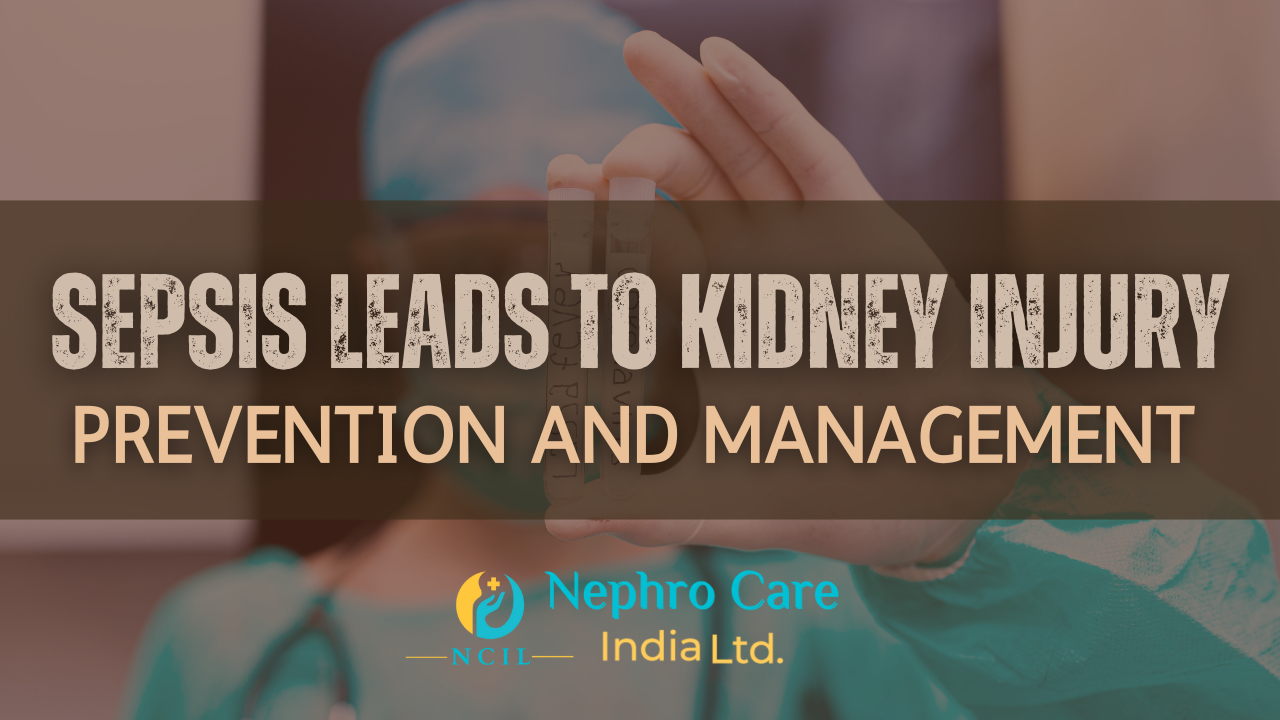How Sepsis Leads to Kidney Injury: Prevention and Management
Sepsis is a life-threatening condition that arises when the body’s response to infection causes injury to its tissues and organs. If it’s incontinently treated it can lead to multiple organ failure and severe medical emergency. Our Kidneys are constantly affected by sepsis. This blog goes through the relationship between sepsis and kidney injury.
SEPSIS
Sepsis occurs when the body’s vulnerable response to an infection becomes dysregulated, leading to uncontrol inflammation. Common causes of sepsis include bacterial, viral, and fungal infections. The immune system’s response to these infections can cause impairement of clotting function, thickning of blood vessels, and diminished blood flow, leading to damage to various organs.
HOW DOES SEPSIS LEAD TO KIDNEY INJURY:
The kidneys are highly susceptible to injury during sepsis due to their role in filtering blood and maintaining fluid and electrolyte balance. Sepsis-induced kidney injury, also known as sepsis-associated acute kidney injury(SA-AKI), occurs through several mechanisms:
- Hypoperfusion: Sepsis can cause a drop in blood pressure, reducing blood flow to the kidneys.
- Inflammation: Excessive inflammation can damage kidney tissues.
- Toxicity: The immune response may release toxins that harm kidney cells.
- Microvascular Dysfunction: Septic infection can cause blood clots in small kidney vessels and injure several functions.
SYMPTOMS OF SEPSIS-ASSOCIATED ACUTE KIDNEY INJURY:
- Fever or Hypothermia
- Increased heart rate breathing rate
- Confusion or altered mental state
- Low urine output
- Swelling in legs, ankles, or feet(Edema)
- Nausea and Vomiting
- Hypotension
DIAGNOSIS:
Diagnosing Septic infection and AKI involves a combination of clinical evaluation and laboratory tests. The key diagnostic ways are:
- Medical History and Physical Examination: Both are necessary to identify signs of infection and organ dysfunction.
- Blood Tests: To check for infection markers, kidney function(Creatinine levels), and other applicable indicators.
- Urinalysis: To detect abnormalities in urine.
- Imaging Studies: Like Ultrasound, to assess kidney structure and function.
TREATMENT OPTIONS:
Early and aggressive treatment is essential for managing septic infection and preventing kidney injury. Treatment strategies are as follows:
- Antibiotics: Broad-spectrum antibiotics to fight infection.
- Fluid Resuscitation: Intravenous fluids to maintain blood pressure and kidney perfusion.
- Vasopressors: Medications to constrict blood vessels and raise blood pressure.
- Dialysis: In severe cases, dialysis may be necessary to perform the kidney’s filtering functions.
- Source Control: Identifying and addressing the source of infection(e.g; draining an abscess).
PREVENTION:
Preventing sepsis and kidney injury involves several strategies, They are:
- Proper hygiene, vaccinations, and prompt treatment of infections are necessary for proper infection control.
- Controlling conditions like diabetes and hypertension can increase the risk of sepsis. Most S-AKI therapies remain non-specific, and early applicable antibiotic therapy is avoided. Secondary renal injury from dependence on sepsis treatment is also prevented.
- Early treatment and recognition are very important. Educating healthcare providers and the public about the signs and symptoms of septic infection.
- Finding biomarkers of renal injury is of great significance for the opinion of S-AKI. Research has shown that both proenkephalin and cystatin C are largely identified with AKI and GFR and creatinine increases before severe sepsis cases, which is helpful for the early vaticination and diagnosis of S-AKI.
CONCLUSION:
Septic infection and Kidney Injury are closely linked, with each condition exacerbating the other. Understanding the signs, causes and treatments are crucial for managing these conditions effectively. If we are at risk, staying informed and seeking prompt medical attention can make a significant difference in outcomes.
REFERENCES:
- Evans L., Rhodes A., Alhazzani W., Antonelli M., Coopersmith C.M., French C., Machado F.R., Mcintyre L., Ostermann M., Prescott H.C., et al. Surviving Sepsis Campaign: International Guidelines for Management of Sepsis and Septic Shock 2021. Crit. Care Med. 2021;49:E1063–E1143. doi: 10.1097/CCM.0000000000005337. – DOI – PubMed
- KDIGO Acute Kidney Injury Work Group KDIGO Clinical Practice Guideline for Acute Kidney Injury. Kidney Int. Suppl. 2012;2:1–138. doi: 10.1038/kisup.2012.1. – DOI
- Dépret F, Hollinger A, Cariou A, et al. Incidence and outcome of subclinical acute kidney injury using penkid in critically Ill patients. Am J Respir Crit Care Med. 2020;202:822–9. https://doi.org/10.1164/rccm.201910-1950OC.
- (PDF) Acute kidney injury from sepsis: current concepts, epidemiology, pathophysiology, prevention and treatment (researchgate.net)
- Vincent JL, Moreno R, Takala J, et al., for the Working Group on Sepsis-Related Problems of the
- European Society of Intensive Care Medicine. The SOFA (Sepsis-related Organ Failure
- Assessment) score to describe organ dysfunction/failure. Intensive Care Med. 1996;22:707–710.
6. Mukherjee, S., Bhaduri, S., Harwood, R. et al. Multiparametric MRI based assessment of kidney injury in a mouse model of ischemia reperfusion injury. Sci Rep 14, 19922 (2024). https://doi.org/10.1038/s41598-024-70401-x. https://doi.org/10.1038/s41598-024-70401-x
7. Acute kidney injury: prevention, detection and management (nice.org.uk)





2024-10-03 14:24:41
Surajit Chakraborti
We should be cautious, thanks for sharing such matter
You're absolutely right! It's important to stay cautious. Thank you for your thoughtful comment. To stay updated on the latest health blogs, visit https://www.drpratim.com/blogs/.